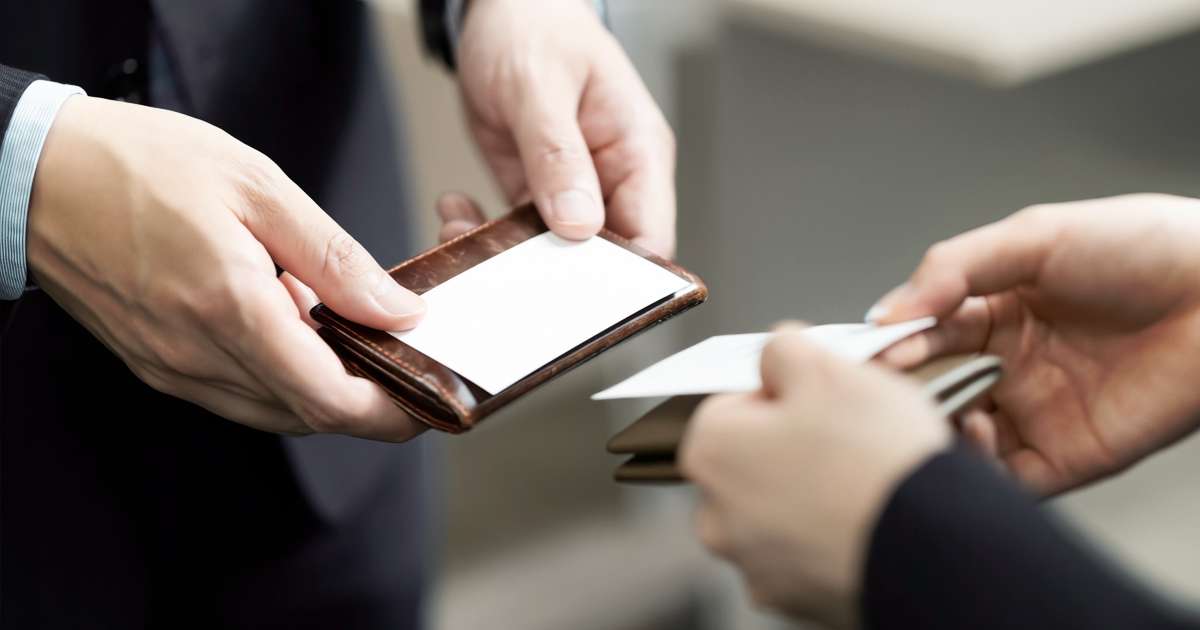What Is The Proper Etiquette When It Comes To Business Cards

Business cards remain enduring instruments in the realm of networking and formal correspondence. Despite the digital age offering a multitude of ways to exchange contact information, these small pieces of cardstock continue to hold importance. They serve as tangible reminders of your identity, profession, and, most importantly, your eagerness to connect. However, the world of business card etiquette is far from universal. It’s crucial to understand the unspoken rules surrounding business cards to ensure your networking efforts are met with success.
What role do business cards play?
Business cards serve as a physical embodiment of your professional identity. They encapsulate your contact information, job title, and company details, offering a concise snapshot of who you are and what you do. This small, portable billboard for your brand plays several crucial roles:
- First Impressions – Your business card is often the first point of contact between you and a potential business connection. A well-designed card can make a lasting positive impression.
- Networking Tool – Business cards facilitate networking by providing an easy and efficient way to share contact information during meetings, conferences, and events.
- Professionalism – The act of exchanging business cards demonstrates professionalism and shows that you take your business relationships seriously.
- International Bridge – When conducting business internationally, understanding and respecting the business card etiquette of a particular region can open doors and strengthen connections.
Business Cards Etiquette Do’s and Don’ts

To make the most of your business cards, it’s essential to adhere to proper etiquette. Here are some do’s and don’ts to keep in mind:
Do’s
- Keep Them Neat – Ensure your business cards are clean, crisp, and free of any damage. A pristine card reflects well on your professionalism.
- Always Carry Them – You never know when a networking opportunity might arise, so always have a stack of cards on hand.
- Exchange with Respect – When giving or receiving a business card, use both hands, especially in Asian cultures like Japan and China. This gesture shows respect and appreciation.
- Study the Card – Take a moment to examine a received business card, acknowledging its importance. In cultures like Japan, failure to do so can be considered rude.
- Write Notes – In North America, it’s acceptable to jot down a few notes on the card you receive to remember key details about the contact.
Don’ts
- Don’t Rush – Avoid immediately shoving a received card into your pocket or wallet. This can be seen as dismissive.
- No Left-Hand Exchange – In many cultures, including Asia and the Middle East, avoid using your left hand when giving or receiving a card, as it’s considered disrespectful.
- Avoid Overuse – Don’t distribute your business card to everyone you meet. Instead, focus on individuals who genuinely require your contact details.
- Don’t Neglect Design – A poorly designed card may reflect negatively on your professionalism, so invest in a well-crafted design.
Business Card Etiquettes from Different Countries
Business card etiquette isn’t one-size-fits-all; it varies across the globe. Here’s a glimpse of how business cards are exchanged in different countries:
Asian Business Card Etiquette
In the vast and culturally diverse continent of Asia, business card etiquette varies widely from country to country. However, certain fundamental principles remain consistent across many Asian nations, emphasizing respect and professionalism in the exchange of business cards.
1. Exchange Cards as a Ritual
In many Asian countries, the exchange of business cards is not just a formality but a ritual that carries deep cultural significance. It is customary to offer your business card whenever you meet someone new, whether in a business context or a social one. This practice demonstrates your eagerness to connect and your commitment to the relationship.
2. Bilingual Cards
When conducting business in Asia, it’s advisable to have business cards printed with dual sides. One side should display your details in your native language, while the other side should feature a translation into the local language. This thoughtful gesture showcases your respect for the local culture and language, making it easier for your business contacts to understand your information.
3. Two-Handed Exchange
How you exchange business cards is equally crucial. To show respect and professionalism, it is customary to use both hands when giving and receiving cards in many Asian cultures. This practice signifies that you value the connection and that you are offering your card with sincerity. The use of both hands is particularly emphasized in countries like Japan, China, and Korea.
4. Formal Titles and Last Names
When addressing individuals in Asia, particularly in countries like India, it is customary to use their titles and last names as a sign of respect. A polite way to address someone is with Mr., Mrs., or Dr., then the last name. Building rapport through formalities is appreciated and fosters a sense of respect in business relationships.
5. Language Choice
While English is widely used in business settings, especially in countries like India, printing your business cards in the local language can be appreciated. This demonstrates an understanding of and respect for the local culture.
Middle Eastern Business Card Etiquette
The Middle East is a region steeped in tradition and cultural nuance. Business card etiquette in this part of the world emphasizes respect and attention to detail, reflecting the importance of personal relationships in business.
1. Careful Card Exchange
The act of exchanging business cards in the Middle East is a practice that should be approached with care and respect. Much like in Asian cultures, it is essential never to use your left hand when giving or receiving a card, as the left hand is traditionally considered impolite.
2. Bilingual Cards
To demonstrate your respect for the local culture, it is advisable to print your business cards in both English and the local language. In this region, the most commonly spoken languages for business include Arabic, Persian, Turkish, Hebrew, Russian, and English. A bilingual approach ensures your card is accessible to a wider audience.
3. Building Personal Connections
Business card exchanges in the Middle East often serve as the initial step in forging personal relationships with new contacts. While the formality varies from country to country within the region, treating business cards with respect and acknowledging their significance is a shared cultural trait.
European Business Card Etiquette
Europe, with its diverse mix of cultures and languages, possesses a relatively relaxed approach to business card exchange compared to some other regions. Here, the emphasis is more on personal contact details than elaborate rituals.
1. Casual Exchange
European business card etiquette tends to be casual, without strict rules governing when or how cards should be exchanged. It is acceptable to hand out your business card at any point in a conversation or meeting, as long as it feels appropriate.
2. Selective Distribution
Unlike some Asian cultures, where business cards are exchanged with virtually everyone, in Europe, it is customary to offer your card primarily to individuals who need direct access to your contact information. Distributing cards to everyone you meet may come across as overly assertive.
3. Language Considerations
While it is generally acceptable to present your business card in English in many European countries, taking the extra step to translate it into the local language is often appreciated. This consideration can help create a favorable impression and demonstrate respect for the local culture.
Business Card Exchange Rules in North America
North America, which encompasses both the United States and Canada, has its own set of business card customs that are typically less formal compared to many other parts of the world.
1. Flexibility in Etiquette
Business card etiquette in North America is relatively flexible. There are no rigid rules dictating when and how to exchange cards. It is common to exchange cards at the beginning of a business meeting or conversation to facilitate introductions.
2. Casual Handout
In many business settings in North America, it is acceptable to hand out your business card casually from a stack. This approach is practical and aligns with the overall informal tone of business interactions in the region.
3. Personal Touch
While maintaining professionalism, there is room for a personal touch when exchanging business cards in North America. It is acceptable to write notes on the cards you receive to remember key details about the contact. This practice can be viewed positively as it demonstrates interest and engagement.
It’s Important to Follow the Right Business Card Etiquette
Today, when the world is so connected, networking is very important for both personal and business growth. Business cards are an important part of making and keeping these contacts. But your business card affects more than just how it looks; it also affects how you hand it to someone.
To make a good impact in a variety of work settings, it’s important to know and follow the different cultural rules and expectations when it comes to business cards. Following the rules for business card manners not only shows that you are professional but also shows that you want to build important relationships in a world where everything is linked. As you start to network, keep in mind that a small piece of paper can lead to big changes if you know how to use it properly.

